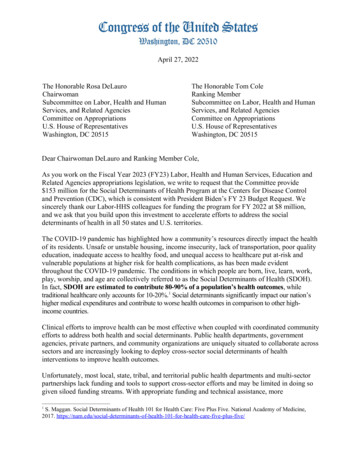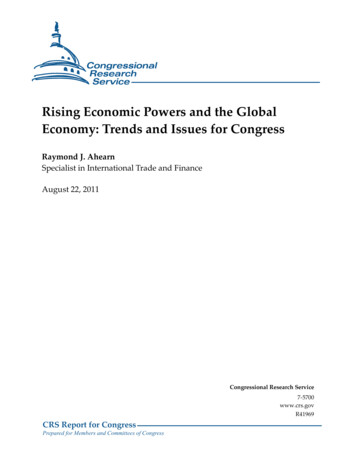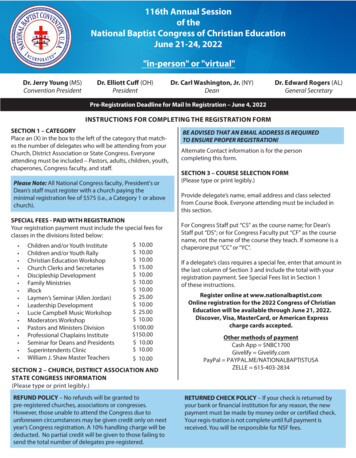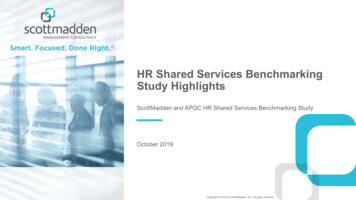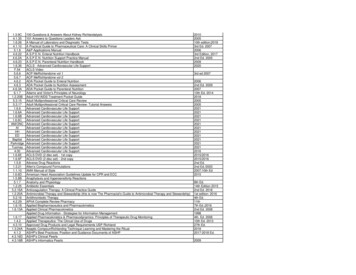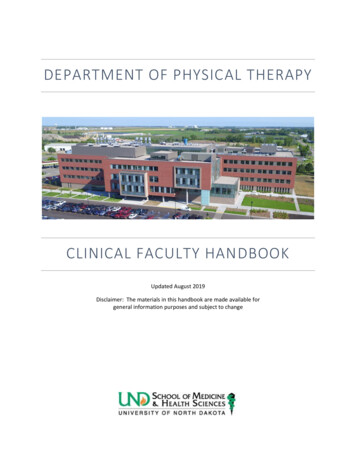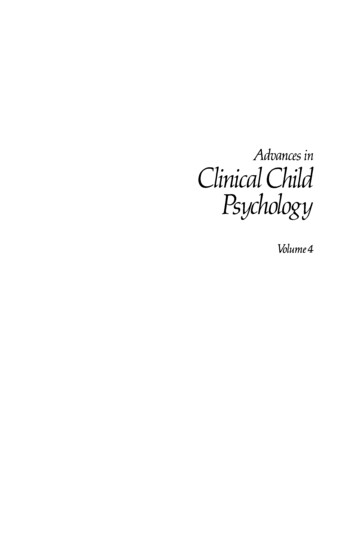
Transcription
CLINICAL 60683North American Congress of Clinical Toxicology (NACCT) Abstracts 20211. Exploration of the binding ofhydroxocobalamin with sulfurcontaining compoundsPatrick Nga, Dennis Lovettb, Maria Castanedac,Crystal Perezd, Joseph Maddrye and Vikhyat BebartafaBrooke Army Medical Center; bUnited States Air Force 59thMedical Wing, Clinical Investigations & Research Support; cUnitedStates Air Force 59th Medical Wing, Science & Technology;dUnited States Army Institute of Surgical Research; eUnited StatesAir Force En route Care Research Center, USAISR, 59th MDW/ST;fUniversity of Colorado DenverBackground: Hydrogen sulfide and methanethiol are toxic chemicals recognized by the US Environmental Protection Agency,Occupational Health and Safety Administration, Department ofDefense, and the Department of Homeland Security. Currently,there is no FDA approved antidote for the treatment of hydrogen sulfide and methanethiol. Previous studies have exploredthe use of cobalt containing compounds, hydroxocobalamin andcobinamide. There are several proposed mechanisms of action ofcobalt containing compounds for treatment of hydrogen sulfideand methanethiol toxicity. One proposed mechanism of actionmirrors that of the treatment of cyanide toxicity with these compounds in that the potential antidote is thought to complex withhydrogen sulfide and methanethiol, or one of its metabolites, directly. Elucidating the mechanism of action will complementin vivo studies testing the efficacy of these compounds forpotential use as countermeasures for certain toxins. To assess themechanism of action, we designed an in vitro study.Methods: Hydroxocobalamin (HOC): In a 250mL Erlenmeyer flaskequipped with a stir bar, 100 milligrams of hydroxocobalaminwas dissolved in 200mL of water. Dilute sodium hydroxide wasadded to the solution, to adjust to physiologic pH (7.0-7.5). Tothis solution, an equimolar amount of either sodium hydrogensulfide (SHS) or sodium thiomethoxide (STM) was added under afume hood, placed on a stir plate and mixed. At 30 minutes, asample was taken from the solution and analyzed via LC/MS todetect if sulfur complexed with hydroxocobalamin and if so, inwhat molar ratio. Aquohydroxycobinamide (AHC): In a 20mL scintillation, vial equipped with a stir bar, 70-100 milligrams of aquohydroxycobinamide was dissolved in 5mL of water. To thissolution, a solution containing a precise amount of either SHS orSTM was added under a fume hood. The volume of the solutionaddition was determined to afford the addition of a full equivalent of thiol over 30 minutes. The system was placed on a stirplate and mixed. At 10-minute intervals, a sample was takenfrom the solution and analyzed via LC/MS to detect if the sulfurcomplexed with aquohydroxycobinamide and if so, in whatmolar ratio.Results: Reaction with a single equivalent of SHS consumed50.9% of HOC after 30 minutes. Analysis at 330 minutes showedno significant further reaction occurred (13.092 mg/mL to 12.952ß 2021 Informa UK Limited, trading as Taylor & Francis Groupmg/mL). This seems to indicate that HOC is capable of reactingwith two equivalents of SHS. The reaction of a single equivalentof SHS resulted in 44.0% consumption of AHC. Addition of asecond equivalent of SHS consumed 89.0% of the starting AHC.The reaction of AHC with one equivalent of STM resulted in areacount of AHC decreasing by 39.8% after 30 minutes. Addition ofa second equivalent of STM consumed 57.7% of the starting AHC.Conclusions: The intent of this experiment was to establish thatthiols react with the cobalt complexed inside a porphyrin ring,such as hydroxocobalamin or aquohydroxycobinamide, and thestoichiometry of the reaction. In the case of HOC, only the reaction with equimolar SHS gave a clear indication that a reactionhad occurred and only one-half of the HOC had been converted.The reactions using AHC and either SHS or STM proceeded to40-44% conversion.patrickcng1@icloud.com2. Glycolic acid exacerbates analyticalperformance of lactate assayMahesheema Alia,b and Darcy RohraaThe MetroHealth System; bCase Western Reserve UniversitySchool of MedicineBackground: The diagnosis of ethylene glycol poisoning can bechallenging due to the limited availability of routine testing. Thetoxic metabolite of ethylene glycol (glycolic acid) is known tofalsely elevate lactate levels. Several published reports have demonstrated the effect of glycolic acid on lactate assays on differentplatforms used in clinical labs. The knowledge gap of the concentrations of glycolic acid that results in significant interferencewith these platforms is not well studied. A difference in themeasured lactate on two platforms, or lactate gap, has been suggested as another screening modality to expedite treatment incase of Eg poisoning. Earlier studies have shown a significantamount of lactate gap between the platforms used in institutions. However, the concentration at which the lactate gap is significant between Radiometer ABL 800, Beckman AU 480, RocheCobas c502, and i-STAT platforms was unknown. The principlesand enzymes used by the platforms are spectrophotometry usinga lactate dehydrogenase (LDH) method (Radiometer ABL 800);photometrically using lactate oxidase and peroxidase method(Beckman AU480); colorimetrically using specific enzyme lactateoxidase and peroxidase (Roche Cobas c502); amperometricallyusing lactate oxidase immobilized on a biosensor (Abbott iSTAT). Herein, the purpose of this study was to evaluate thedose-response effect of glycolic acid on lactate assay platforms inthe clinical labs. A secondary objective was to determine if thesufficient lactate gap might be a useful tool for evaluating possible ethylene glycol poisoning.
2ABSTRACTSMethods: This study has been reviewed by the InstitutionalReview Board (IRB) and it has been determined that it is exemptfrom IRB review. Herein, we tested the effect of different concentrations of glycolic acid (0.01-46mM) on the lactate assay byusing central lab and the point of care (POCT) analyzersRadiometer ABL 800, Beckman AU480, Roche Cobas c502, Abbotti-STAT. Furthermore, we compared the significant bias in thesamples in the spiked versus unspiked serum samples on all thequantitative platforms.Results: Measurement of lactate with increasing concentrationsof glycolic acid on Beckmann AU480 did not show any significantbias. However, Radiometer ABL 800, Roche Cobas c 502, and iSTAT platforms resulted in false-positive lactate results. Glycolicacid at a concentration of 0.007-0.03mM (0.55-2.2 ug/mL)resulted in 10% bias on all the four platforms. Glycolic acidconcentration 0.06 mM (4.4ug/mL) resulted in 10% positivebias on Radiometer ABL 800 and concentration 0.12 mM(8.8ug/mL) resulted in 10% positive bias on both Abbott I-statand Roche Cobas 502. Also, it is noteworthy that at concentrations 0.06mM, we see a much-pronounced lactate gap betweenABL 800 and both Roche Cobas c 502 & i-STAT. Further, the lactate gap between i-STAT and Roche Cobas 502 increases at concentration 0.46Mm(35ug/mL).Conclusion: Our data in entirety suggest that minute concentrations of glycolic acid resulted in significant bias which couldresult in misdiagnosis. Our results demonstrate a positive biasfrom glycolic acid that becomes more pronounced at increasingglycolate concentration and would result in an increasing lactategap between platforms. Falsely elevated lactate levels couldresult in misdiagnosis if the clinicians are unaware of interference.mali3@metrohealth.org3. The diagnostic value of D-dimer inaustralian snake envenoming (ASP-29)Geoffrey IsbisterClinical Toxicology Research Group, University of NewcastleObjective: The early identification of snakebite patients with systemic envenoming is essential for early antivenom treatment,including early detection of venom induced consumption coagulopathy (VICC). We investigated the diagnostic accuracy of Ddimer for detection of VICC and complications.Methods: We reviewed all patients from the prospectiveAustralian Snakebite Project (ASP;2005-2018), in which a quantitative D-dimer was measured. Bite time, clinical effects and laboratory investigations were extracted. Cases were classified as nonenvenomed snakebites (normal controls), envenomed withoutVICC, envenomed with VICC and VICC with thrombotic microangiopathy or acute kidney injury based on defined clinical andlaboratory criteria. The predictive performance of a quantitativeD-dimer in diagnosing envenoming, with and without VICC wastested using area under the receiver-operating-characteristiccurve (ROC-AUC).Results: There were 1316 snakebites: 761 envenomed patients,562 with VICC and 199 with envenoming but no VICC. 1029patients had a D-dimer available within 6h post-bite. Plots of themedian D-Dimer versus time showed that 95% of patients withVICC had a D-Dimer 4mg/L by 4h post-bite and 95% of nonenvenomed patients had a D-dimer 2mg/L during the first 6hpost-bite. A D-dimer within 6h post-bite predicted VICC with anAUC-ROC, 0.96 (95%CI:0.94-0.97), and a cut-point of 1.5mg/Lgives a sensitivity of 89% and specificity of 98%. In patients withnormal coagulation studies, a D-dimer within 6h post-bitepredicted VICC with an AUC-ROC, 0.98 (95%CI:0.96-1.00;cut-point1.4mg/L: sensitivity 89%, specificity 98%). All patients with thrombotic microangiopathy or acute kidney injury had a D-Dimer 4mg/L after 3h, except two patients who only had a D-dimerwithin 2h.Conclusion: Our study supports an early quantitative D-Dimerfor diagnosis of VICC in snakebite patients, optimally 2-4h for itto be diagnostic and sufficiently early for antivenom administration within 6h. A D-dimer 4mg/L at 6h excluded snake-biteassociated thrombotic microangiopathy and acute kidney injury,complications of VICC.geoff.isbister@gmail.com4. Characterization of F(ab’)2 and Fabcrotalidae antivenom single andcombination therapy 2018-2020:retrospective analysis of the NorthAmerican Snakebite RegistryChristopher Pitottia, Sabrina Kaplanb, Anne-MichelleRuhac,d, Brian Wolke and Christopher Hoytef, onbehalf of the North American Snakebite StudyGroupaRMPDS; bDenver Health Emergency Medicine; cToxIC NorthAmerican Snakebite Study Group; dBanner University MedicalCenter Phoenix; eDepartment of Emergency Medicine, Loma LindaUniversity, CA, USA; fRocky Mountain Poison and Drug SafetyBackground: Equine F(ab’)2 crotalidae antivenom became available in the United States in late 2018. Previous studies have evaluated this F(ab’)2 therapy in comparison to ovine Fab crotalidaeantivenom as single agents, but the utilization of combinationantivenom therapy is not well described. This study investigatesthe utilization and effectiveness of this combination of antivenoms for rattlesnake envenomation in comparison to singleagent therapy.Methods: Hospital visits for identified rattlesnake envenomationswith complete data were extracted from the 2018-2020Toxicology Investigators Consortium North American Snake BiteRegistry. Data were divided into four therapy groups: Fab-only,F(ab’)2-only, Fab-first, and F(ab’)2-first. Descriptive statistics wereutilized, and comparisons performed with chi-squared, t-test orWilcoxon tests when appropriate. Dosing equivalents (DE) arerecorded as a 10:5 vial correction for F(ab’)2 and Fab antivenoms.Results: The registry contained 279 patients given antivenom.Fab-only therapy occurred in 100%, 43.6%, and 27.5% of cases in2018, 2019, and 2020, respectively. Only 4 states utilized F(ab’)2(AZ, NM, CO, CA). Combination therapy accounted for 30.9% and32.5% of 2019 and 2020 cases. Only 6 cases of F(ab’)2-first combination therapy were identified and 3 had early adverse reactions. 159 Fab-only, 60 F(ab’)2-only, and 54 Fab-first cases wereidentified with median (IQR) durations of antivenom therapy 14.5(0-26), 6.9 (0-17.3), and 16.1 (8.7-23.1) hours, respectively. Theduration of F(ab’)2-only therapy was significantly shorter thaneither Fab-first (p 0.01) or Fab-only (p 0.03) with 38 patientsgetting maintenance dosing in the Fab-only group.Hospitalization was less than 48 hours in 69.9% of patients butthis was not significantly different between groups. Signs ofpost-hospitalization serum sickness occurred in 3.2% of Fab-only,6.7% F(ab’)2-only, and were not recorded in Fab-first. Post-hospitalization antivenom was given in 5 cases, all in the Fab-onlygroup. Rehospitalization occurred in 3.1% of Fab-only, 3.3% ofF(ab’)2-only, and 7.4% of Fab-first. Median DE (IQR) required forinitial hospitalization were 2.4 (1.2-3.6) Fab-only, 1.8 (1-2.5)
CLINICAL TOXICOLOGYF(ab’)2-only, 2.8 (2.2-3.8) Fab-first. Adverse reactions occurred in13.0% of Fab-first cases vs 2.5% of Fab-only and 3.33% F(ab’)2only (p 0.01). Outside hospital transfers were reported in 72.2%of the Fab-first group vs 37.7% Fab-only (p 0.01), and 61.7%F(ab’)2-only. Late thrombocytopenia (platelets 120 K/mm3) wasrecorded in 22% of Fab-only vs 3.3% of F(ab’)2-only (p 0.001)and 9.3% of Fab-first (p 0.05). Late coagulopathy (prothrombintime 15 sec) and hypofibrinogenemia (fibrinogen 170 mg/dL))were present more frequently in Fab-only therapy than bothother groups.Conclusion: In the 2018-2020 North American Snake BiteRegistry combination therapy with F(ab’)2 and Fab was morelikely associated with early adverse events and outside hospitaltransfers though characterization was limited by the rarity ofF(ab’)2-first therapy. F(ab’)2-only therapy was associated withfewer dose equivalents, and shorter duration of antivenom therapy. No significant differences were detected in the rate of hospitalization under 48 hours. Fab-only therapy was more closelyassociated with antivenom required at follow up, late thrombocytopenia, coagulopathy, and hypofibrinogenemia.3seen was in one patient from a baseline of 1.07 to 1.32 in for the550 mcg/mL concentration. Increases in concentrations to supraphysiologic levels resulted in a non-linear increase in INR. Therewas a statistically significant increase in INR at 2000 mcg/mL forthe Stago analyzer (p ¼ 0.030) and at 4000 mcg/mL for both analyzers (p 0.0001).Conclusion: At therapeutic concentrations, the in vitro interference of NAC appears to not affect INR measurement.Faisal.Minhaj1@gmail.com6. New insights on acetaminophenhalf-life using multisourcepharmacokinetic dataGrant Comstocka, Christopher Hoytea, Mark Yaremab,Richard Dartc, Barry Rumackd and Daniel Spykereacpitotti@gmail.com5. In vitro analysis of N-acetylcysteine(NAC) interference with theinternational normalized ratio (INR)Faisal Minhaja, James Leonarda, Hyunuk Seungb,Wendy Klein-Schwartza, Bruce Andersona andJoshua KingaaMaryland Poison Center, University of Maryland School ofPharmacy; bUniversity of Maryland School of PharmacyBackground: Previous literature suggests a laboratory interference of n-acetylcysteine (NAC) with prothrombin time (PT) andthe international normalized ratio (INR). Early publicationsfocused on this interaction in the setting of an acetaminophenoverdose and evaluated the INR of patients receiving intravenousNAC. However, there is limited literature describing the concentration-effect relationship of NAC to INR measurement in theabsence of acetaminophen-induced hepatotoxicity at therapeuticNAC concentrations. The purpose of the study is to quantify thedegree of interference of NAC on INR values at therapeutic concentrations correlating to each infusion of the regimen (ex. bag1: 550 mcg/mL, bag 2: 200 mcg/mL, bag 3: 35 mcg/mL, doublebag 3: 70 mcg/mL) and at supratherapeutic concentrationsin vitro.Methods: Blood samples were obtained from 11 volunteer subjects. Each blood sample was transferred into vials containing0.3 mL buffered sodium citrate 3.2% and spiked with various concentrations of NAC for final concentrations of 0, 35, 70, 200, 550,1000, 2000, and 4000 mcg/mL. The samples were centrifugedand tested to determine PT and INR on two separate machines:Siemens CS-2500 and Stago SN1114559. We would require asample size of 6 to achieve a power of 80% and a level of significance of 1.7% (two-sided), for detecting a mean difference of 0.4between pairs, assuming the standard deviation of the differences to be 0.2. Differences between INRs at varying concentrationswere determined by a one-way ANOVA with multiple comparisons. Analyses were performed using GraphPad Prism 9.0.0.Results: Participants included 11 healthy subjects: 8 males, 3females, median age 30 years (range 25–58). Mean and standarddeviation INR for the control samples were 1.10 0.09 forSiemens and 1.00 0.07 for Stago analyzers. There was no clinically significant difference noted for any of the therapeutic concentrations (35, 70, 200, or 550 mcg/mL). The largest INR increaseRocky Mountain Poison and Drug Safety; bPoison and DrugInformation Service, Alberta Health Services; cRocky MountainPoison and Drug Information; dUniversity of Colorado School ofMedicine; eOregon Poison Center, Oregon Health & SciencesUniversityBackground: The elimination half-life of acetaminophen (APAP)is believed to increase in APAP overdose as well as in states ofhepatic dysfunction. The most robust previous APAP half-life analysis was limited to 2 large datasets containing exclusively overdose data, bringing into question the generalizability of thefindings. We expand upon prior work by utilizing a large, multisource pharmacokinetic (PK) dataset that combines data fromoverdose cases with intensively sampled PK data from randomized controlled trials (RCTs) to better characterize APAP half-lifepredictors.Methods: We examined 21,848 APAP concentrations from 6,657cases admitted to hospital or participating in RCTs comparingAPAP preparations or supratherapeutic doses. We initiallyselected cases with 3 or more measured [APAP] and excludedlast concentrations which were below the level of quantitation(BLQ) which left 3,952 cases. We carried out 8,443 linear regressions, beginning with the last 3 levels and iteratively repeatingout to the last 20 levels. We then selected the best linear regression for each of the 3,952 cases. Of these, 2,466 cases had bestregression p-value 0.05 and comprised our PK dataset.Outcome measures included max aminotransferases (AST, ALT),max INR, and max bilirubin. Data which were log-normally distributed were log transformed. Predictors of half-life wereselected by stepwise multiple regression with p-value thresholdsof 0.1 to enter and 0.05 to leave. R-squared, the fraction of thehalf-life variability described by the model (rsqr) was reported.LogWorth and Pvalue were used to assess the statistical contribution of each predictor. All data handling and analyses were viaSAS JMP 16.0.1.Results: Acceptable PK data were available in 18 studies, including 15 overdose studies and 3 RCTs. The analysis datasetincluded 11,308 [APAP] from 2,466 cases (2,369 from overdosestudies, and 97 from RCTs). The RCT population yielded 840[APAP], averaging over 8 [APAP]per case. Median [min,max] APAPhalf-life was 3.7 [1.09, 62.17] hours, 7 patients received livertransplantation and there were 14 deaths. Only 554 cases wereincluded in the multivariate model as outcome measures werenot universally available. The best multivariate model for half-lifeprediction included peak aminotransferases, [APAP], and [bilirubin] (n ¼ 554, rsqr ¼0.46, p 0.0001). Patient historical data,including age, and presence or absence of co-ingestions contributed relatively less or not at all to the final model.
4ABSTRACTSConclusions: The incorporation of robust APAP PK data fromadditional overdose and RCT settings expands upon our abilityto predict APAP half-life. Consistent with prior studies, historicaldata such as demographics, pre-existing medical conditions orquantity of ingestion were either minor contributors or non-contributory to half-life prediction. Outcome data along with thepeak APAP concentration remain central in predicting half-life.However, our analysis found INR to be a less significant predictorthan previously described, while transaminases and bilirubinwere comparatively greater contributors. This broadened andinclusive population PK study improves our understanding of thephysiologic contributors governing APAP half-life and may ultimately allow for early prediction of outcome in the futureResults: A total of 373 patients met inclusion for the study. Ofthose, 135 cases were treated with standard dose IV NAC, 121cases treated with PO NAC, and 117 cases treated with highdose IV NAC. The risk of developing hepatotoxicity was not statistically significant between the high dose IV NAC (OR 1.05, 95%CI 0.52 – 2.09) or oral NAC (OR 0.69, 95% CI 0.33 – 1.46) whencompared to standard dose IV NAC. When adjusted for APAPproducts, APAP ratio, initial elevated AST/ALT, and treatmentwithin 8 hours, there remained no difference in treatment regimens and risk of developing hepatotoxicity.Conclusion: This is the first study to compare all three NAC regimens in the setting of acute massive acetaminophen ingestion.Our findings suggest that high dose IV NAC does not decreasethe odds of developing hepatoxicity in this patient n.org7. Evaluation of N-acetylcysteine dosefor the treatment of massiveacetaminophen ingestionJustin Lewisa, Mia Limb, Edgardo Mendozac, LeslieLaia, Timothy Albertsona and James ChenowethdaCalifornia Poison Control System - Sacramento Division;Department of Pharmacy Services, UC Davis Health; cUCSF Schoolof Pharmacy; dDivision of Medical Toxicology, UC Davis MedicalCenterbBackground: The use of N-acetylcysteine (NAC) remains thestandard of care for treatment of acetaminophen (APAP) toxicityand overdose. Currently, there is growing evidence to suggestthat massive acetaminophen overdose is associated withincreased hepatotoxicity despite timely administration of NAC.This raises the question as to whether an increased dose of intravenous (IV) NAC should be used in the setting of massive APAPingestion. This study aimed to evaluate the rate of hepatotoxicityafter massive APAP overdose treated with 3 different NAC treatment regimens.Methods: This was a retrospective cohort study conducted byelectronic medical record chart review of cases reported to astatewide poison control system between 2007 and 2020.Inclusion criteria: Single substance APAP or APAP combo agentingestion; acute massive APAP ingestion (defined as APAP concentration at least 2 times the Rumack-Matthew 150 nomogram);received one of the three NAC regimens: standard dose IV NAC,standard dose oral (PO) NAC, or high dose IV NAC (150 mg/kg IVloading dose followed by 50 mg/kg infusion over 4 hours followed by 200 mg/kg infusion over 16 hours). Exclusion criteria:multi-substance ingestions; unknown time of ingestion; AST/ALTnot recorded; chronic or staggered ingestions; received both IVand PO NAC, AST/ALT 1000 U/L prior to treatment, presentationto the emergency department 24 hours post ingestion. Datacollected: age, sex, APAP product (APAP alone vs. combinationproduct), time since ingestion, APAP concentration, initial AST/ALT, whether NAC was started within 8 hours post ingestion,whether hepatotoxicity developed (defined as AST/ALT 1000 U/L), and medical outcome. An APAP ratio was determined tostandardize the APAP concentration for different times by dividing the concentration by the corresponding value on theRumack-Matthew 150 nomogram line. ANOVA was used for normally distributed continuous variables, Kruskal-Wallis test fornon-normally distributed variables, and chi-square for categoricalvariables. The risk of hepatotoxicity was evaluated using multivariate logistic regression model with standard dose IV NAC asthe base variable for comparison between dosing regimens.8. Outbreak of hepatitis of unknownetiology associated with bottledalkaline water ingestionColin Therriaulta,b, Daniel Nogeea,b, Jeanne Ruffc,d,Devin Ramand, Matthew Hudsonc, Richard Wangaand Arthur ChangaaCenters for Disease Control and Prevention National Center forEnvironmental Health; bEmory University; cCenters for DiseaseControl and Prevention; dSouthern Nevada Health DistrictBackground: Liver injury can have numerous etiologies.Toxicological causes are often considered after infectious, autoimmune, metabolic, and genetic causes have been eliminated.There have been multiple prior outbreaks of toxic hepatitis,though not all of them have had a causative agent identified.We present a cluster of suspected toxic hepatitis cases amongpatients with exposure to a commercially available alkaline waterproduct.Cases: During 11/23/2020 to 12/4/2020, a regional health department was notified of five cases of severe acute hepatitis ofunknown etiology in patients aged 7 months to 5 years. Theseinitial patients presented with complaints of vomiting, poor oralintake, and fatigue. Clinical investigation noted elevated hepatictransaminases, hyperbilirubinemia, and coagulopathy. All patientswere transferred to a pediatric liver transplant center. Despiteextensive workup no cause was identified. During hospitalizationthe patients received antibiotics (5/5), antivirals (5/5), vitamin K(5/5), cryoprecipitate (3/5), fresh frozen plasma (3/5), and n-acetylcysteine (1/5). One patient required intubation due to encephalopathy and need for airway protection. Two patientsunderwent liver biopsy; both showed non-specific hepatocyteballooning without necrosis, while one biopsy also showedmarked macrovesicular steatosis and mild eosinophilia. Allpatients showed rapid clinical and biomarker recovery (mean13.4 days from onset of symptoms to hospital discharge). Reviewof medical records and further exposure history obtained by theregional health department revealed that all case patientsingested a specific brand of commercially sold alkaline water.The mean time from first consumption to symptom onset was9.4 months; all patients consumed the product up to the time ofsymptom onset. No other common exposures or epidemiologiclinkages were identified.Discussion: Thus far, a public health investigation identified 11probable cases of severe new-onset hepatitis of unknown etiology as of 5/11/2021 (patients aged 7 months – 71 years),including the initial patients. Medical record review showed mostcases presented with non-specific symptoms; a minority of cases
CLINICAL TOXICOLOGYalso showed clinical evidence of hepatic injury, including jaundice and altered mental status.) Laboratory results showed evidence of marked liver injury with hepatocellular predominance,often with severe coagulopathy. A third biopsy from an adultpatient showed a pattern of macro and microvesicular steatosis.All currently identified probable case patients recovered withoutrequiring liver transplant. Current data raises concern for a hepatotoxin that can cause variable findings on biopsy; however, themulti-agency investigation is ongoing and an identifiable causative agent has yet to be discovered as of 5/11/2021. Currently,the manufacturer has recalled the product and the investigationcontinues, seeking to identify additional cases and a potentialagent or contaminant.Conclusions: The identified common source of alkaline waterexposure, rapid recovery after removal of that exposure, and lackof other identified cause despite broad and thorough workupstrongly suggests an exposure to an as-of-yet unidentified hepatotoxin. These cases demonstrate the importance of an exposure history and the need for a high index of suspicion fortoxicologic causes of liver injury.ctherr2@emory.edu9. Validity and reliability of thepoisoning severity score in a pediatricpoisoned populationElisabeth Canitrot, Lynne Moore, Alexis Turgeon andMaude St-OngeCHU de Qu ebec Research Center, Population health and optimalhealth practices axisBackground: Hospital management of a poisoned child involvesa systematic assessment of the severity of the child’s condition.Recently, the Poisoning Severity Score (PSS) was developed toevaluate the severity of poisoning. However, this tool is insufficiently validated in children where the generic Pediatric LogisticOrgan Dysfunction Score (PELODS) is preferred. We aimed toassess the predictive validity and reliability of the PSS in measuring the severity and progression of the intoxication in children ascompared to the PELODS.Methods: We conducted a multicenter retrospective cohortstudy using retrospective data collected from health records ofhospitalizations between 2013 and 2016 at three health carefacilities in our Canadian province. All poisoned children aged 0to 17 years old were included if managed in the emergencydepartment (ED) within 12 hours of ingestion of a potentiallytoxic dose of an activated charcoal-adsorbable substance. ThePSS and PELOD scores were measured on arrival at the ED andagain 12 hours later. Logistic regression was used to estimate thediscriminatory ability of the initial PSS and the 12-hour delta PSSto predict admission, intensive care unit (ICU) hospitalization,hospital length of stay 12 hours, and the need for follow-upafter discharge. Inter-rater reliability of the PSS was measuredusing weighted Kappa coefficients.Results: Of the 469 subjects included in the study, 140 (30%)were admitted to the hospital, including 109 (23%) in the intensive care unit (ICU). One hundred eighty-nine (40.3%) were hospitalized 12 hours or more, and 83 (18%) were discharged to apsychiatric facility or with a follow-up in psychiatry. An initial PSSof 0 was observed for 97% of non-hospitalized subjects versus58% of admitted subjects (p 0.05). The areas under the receiving operating characteristics curves (AUC) for the initial PSS andthe 12-hour delta PSS were respectively 0.690 (95% confidenceinterval (CI) 0.649-0.732) and 0.626 (95% CI 0.581-0.670) for hospital admission; 0.649 (95%CI 0.601-0.697) and 0.604 (95% CI50.555-0.652) for ICU admission; 0.666 (95% CI 0.632-0.700) and0.609 (95% CI 0.572-0.645) for a hospital length of stay 12 hours; and 0.569 (95% CI 0.519-0.620
Christopher Pitottia, Sabrina Kaplanb, Anne-Michelle Ruhac,d, Brian Wolke and Christopher Hoytef,on behalf of the North American Snakebite Study Group aRMPDS; bDenver Health Emergency Medicine; cToxIC North American Snakebite Study Group; dBanner University Medical Center Phoenix; eDepartment of Emergency Medicine, Loma Linda
